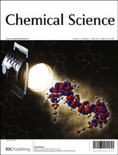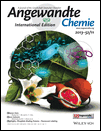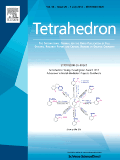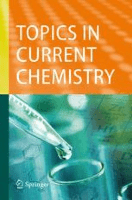
Chemical Science
Scope & Guideline
Empowering Researchers Through Open Access
Introduction
Aims and Scopes
- Catalytic Processes and Mechanisms:
Research focusing on novel catalytic systems, including metal- and organocatalysis, and their mechanisms of action, particularly in the context of sustainable chemistry and energy conversion. - Materials Chemistry:
Innovations in the design, synthesis, and application of advanced materials, including nanomaterials, polymers, and metal-organic frameworks, with a focus on their physical and chemical properties. - Biochemical Applications and Drug Discovery:
Studies that explore the chemical basis of biological processes, including enzyme design, drug development, and the use of synthetic methodologies for therapeutic applications. - Computational Chemistry and Machine Learning:
Utilization of computational techniques and machine learning approaches to predict chemical properties, reaction mechanisms, and to facilitate the design of new materials and compounds. - Environmental Chemistry and Sustainability:
Research addressing environmental challenges through chemical innovations, including CO2 reduction, waste recycling, and the development of green chemistry practices. - Photochemistry and Photophysics:
Investigation into the interactions of light with matter, including the design of photosensitizers, photodynamic therapy agents, and the study of excited-state dynamics.
Trending and Emerging
- Sustainable Chemistry and Green Technologies:
There is a rising trend in research aimed at developing sustainable chemical processes, including renewable energy sources, waste reduction, and environmentally friendly materials. - Machine Learning and AI in Chemistry:
The integration of machine learning and AI techniques for predictive modeling, reaction optimization, and materials discovery is rapidly gaining momentum, driven by the need for efficiency and innovation. - Photocatalysis and Photo-Driven Reactions:
Research focused on photocatalytic processes for energy conversion and organic transformations is increasing, particularly in the context of CO2 reduction and solar energy harvesting. - Dynamic and Responsive Materials:
The development of materials that can respond to environmental stimuli (e.g., pH, temperature, light) is trending, with applications in drug delivery, sensors, and smart materials. - Bioconjugation and Targeted Therapy:
Innovations in bioconjugation techniques for drug delivery and targeted therapy are emerging, highlighting the importance of precision medicine and personalized treatment approaches. - Nanotechnology and Nanomaterials:
There is a growing focus on the synthesis and application of nanomaterials in various fields, including catalysis, electronics, and biomedical applications, emphasizing their unique properties and functionalities.
Declining or Waning
- Traditional Organic Synthesis Techniques:
There is a noticeable decline in publications focused on classical organic synthesis methods, as researchers increasingly adopt modern techniques such as photoredox catalysis and flow chemistry. - Inorganic Coordination Chemistry:
Research in traditional inorganic coordination complexes has waned as the field shifts toward more complex systems that incorporate organic components and hybrid materials. - Low-Impact Environmental Studies:
While environmental chemistry remains a core area, studies that do not incorporate innovative methodologies or technologies to address sustainability are becoming less frequent. - Static Theoretical Chemistry:
Theoretical studies relying solely on static models without incorporating dynamic or real-time data are decreasing, as there is a growing emphasis on methods that capture the complexities of chemical systems. - General Chemical Education Publications:
There has been a reduction in publications focused on basic chemical education, as the journal increasingly prioritizes cutting-edge research and applications.
Similar Journals

ANGEWANDTE CHEMIE-INTERNATIONAL EDITION
Exploring the Frontiers of Chemical InnovationANGEWANDTE CHEMIE-INTERNATIONAL EDITION, published by WILEY-V C H VERLAG GMBH, stands as a leading journal in the fields of Chemistry and Catalysis, holding a prestigious position with a Q1 ranking in both categories as of 2023. With an ISSN of 1433-7851 and an E-ISSN of 1521-3773, this esteemed publication has been an invaluable resource for the global scientific community since its inception in 1962. The journal's impact is further underscored by its remarkable Scopus rankings, where it occupies the 13th place among 408 journals in General Chemistry and the 4th place among 68 in Chemical Engineering - Catalysis, marking it in the 96th and 94th percentiles, respectively. Although it does not offer Open Access, ANEWANDTE CHEMIE-INTERNATIONAL EDITION remains essential for researchers, professionals, and students seeking to stay abreast of cutting-edge developments and innovations in chemical sciences. Its comprehensive scope and rigorous peer-review process ensure that only the highest quality research finds its way to publication, contributing significantly to the advancement of chemistry worldwide.

TETRAHEDRON
Transforming ideas into impactful scientific discoveries.TETRAHEDRON, published by Pergamon-Elsevier Science Ltd, is a leading peer-reviewed journal that has been pivotal in advancing the fields of Biochemistry, Drug Discovery, and Organic Chemistry since its inception in 1957. With an ISSN of 0040-4020 and an E-ISSN of 1464-5416, this journal provides a platform for the dissemination of cutting-edge research and innovative methodologies that contribute significantly to the scientific community. Recognized for its rigorous editorial standards, TETRAHEDRON has been categorized in the Q3 quartile for 2023 across its relevant fields, reflecting its solid impact within the scientific sphere. Despite the current absence of Open Access options, the journal continues to engage a diverse readership, offering invaluable insights and advancements that fuel both academic and industrial applications. With an ongoing commitment to excellence, TETRAHEDRON remains an essential resource for researchers, professionals, and students aiming to stay at the forefront of chemistry and biochemistry research.

Topics in Current Chemistry
Exploring the forefront of chemical innovation.Topics in Current Chemistry is an esteemed peer-reviewed journal published by SPRINGER INT PUBL AG, renowned for its contributions to the field of chemistry. Established in 1974 and currently spanning its convergence through various years, this journal remains pivotal for researchers seeking to explore the latest developments in chemical sciences. With an impressive Q1 classification in the miscellaneous chemistry category and a Scopus rank placing it in the top 10% of its field, it serves as a crucial platform for disseminating high-quality research. The journal’s diverse scope covers a wide array of contemporary chemical topics, catering to a global audience of academic and professional chemists. Although not Open Access, its content can be accessed through institutional subscriptions, ensuring broad reach and engagement within the scientific community. Researchers and students alike will find Topics in Current Chemistry an invaluable resource for keeping abreast of cutting-edge advancements and trends in chemistry.

RUSSIAN CHEMICAL REVIEWS
Your Gateway to High-Impact Chemical ResearchRUSSIAN CHEMICAL REVIEWS, published by the esteemed ND Zelinsky Institute of Organic Chemistry, RAS, stands as a prominent platform for disseminating high-quality research in the diverse field of chemistry. With an ISSN of 0036-021X and an E-ISSN of 1468-4837, this journal has earned its place in the Q1 quartile of Chemistry (miscellaneous) for 2023, reflecting its outstanding impact and rigorous peer-review process. The journal encompasses a wide array of topics within chemistry, providing critical reviews that advance understanding and foster collaboration among researchers, professionals, and students globally. With its consistent publication since 1970, RUSSIAN CHEMICAL REVIEWS not only serves as a valuable resource for the latest advancements in the field but also plays a crucial role in shaping future research directions. The journal is based in the Russian Federation, with its office located at 47 Leninsky Pr, Moscow 119991, RUSSIA. As an essential reference for those in the chemical sciences, it provides an ideal avenue for authors looking to publish impactful reviews that contribute to the broader scientific community.

CHEMISTRY-A EUROPEAN JOURNAL
Elevating Research Standards in Organic ChemistryCHEMISTRY-A EUROPEAN JOURNAL is a premier academic journal published by WILEY-V C H VERLAG GMBH, specializing in the diverse fields of chemistry and catalysis, with a distinguished focus on organic chemistry. Since its inception in 1995, the journal has established itself as an authoritative resource for researchers and professionals, currently classified in Q1 in Chemistry (miscellaneous) and Organic Chemistry, reflecting its high-quality contributions to the scientific community. With an impressive impact factor and robust Scopus rankings—#33 in Organic Chemistry and #26 in Catalysis—this journal serves as a vital platform for disseminating innovative research findings and critical advancements in chemical sciences. Although not an open-access journal, it provides valuable access options for institutions, ensuring wide reach and engagement within the scientific community. As it converges into 2024, CHEMISTRY-A EUROPEAN JOURNAL remains a key resource for anyone dedicated to advancing the frontiers of chemistry research.

DOKLADY PHYSICAL CHEMISTRY
Illuminating Insights in the World of Physical ChemistryDOKLADY PHYSICAL CHEMISTRY is a prominent peer-reviewed journal published by MAIK NAUKA/INTERPERIODICA/SPRINGER, focusing on advancements and research in the field of Physical and Theoretical Chemistry. With the ISSN 0012-5016 and E-ISSN 1608-3121, this journal serves as a vital platform for researchers and practitioners to disseminate their findings and insights from 1996 to the present. Despite its current Q4 ranking in the 2023 category of Physical and Theoretical Chemistry, the journal has shown significant potential for visibility and engagement within the academic community, ranking #149 out of 189 in its respective field according to Scopus metrics, highlighting its dedicated readership. While the journal is not open access, it remains an essential resource for those seeking in-depth research articles, reviews, and commentary within this dynamic discipline. As the field continues to evolve, DOKLADY PHYSICAL CHEMISTRY plays a crucial role in fostering scientific dialogue and collaboration among researchers, professionals, and students worldwide.

Chem Catalysis
Pioneering insights in organic and physical chemistry.Chem Catalysis is a leading academic journal published by CELL PRESS, specializing in the diverse and dynamic field of chemistry. Since its inception in 2021, this open-access journal has rapidly ascended to prominence, holding Q1 quartile rankings in prestigious categories including Chemistry (Miscellaneous), Organic Chemistry, and Physical and Theoretical Chemistry. With its Scopus rankings placing it in the top tiers—Rank #14 in Organic Chemistry and Rank #12 in Miscellaneous Chemistry—Chem Catalysis serves as a vital platform for disseminating innovative research and catalysis science. Researchers and professionals seeking to stay abreast of cutting-edge developments will find this journal indispensable for advancing their knowledge and contributions to the field. Located in Cambridge, Massachusetts, Chem Catalysis is committed to fostering collaboration and innovation in the chemical sciences, paving the way for breakthroughs that address global challenges.

JOURNAL OF THE INDIAN CHEMICAL SOCIETY
Illuminating India's Contributions to Global Chemical ResearchJournal of the Indian Chemical Society, published by Elsevier, stands as a cornerstone in the field of chemistry, particularly representing the rich chemical research emanating from India.
With a significant history dating back to its establishment, this journal encompasses diverse disciplines including Drug Discovery, Electrochemistry, Inorganic Chemistry, Organic Chemistry, and Physical and Theoretical Chemistry, reflecting the evolving landscape of chemical sciences.
Despite being positioned in the Q3 category across multiple quarters, the journal demonstrates promising rankings in various chemistries, highlighting its commitment to advancing the knowledge and application of chemical sciences. While currently not available as an open access journal, the Journal of the Indian Chemical Society is dedicated to providing a platform for high-quality research that fosters innovation and collaboration among researchers, professionals, and students worldwide.
With its continuous publication from 1973 to the present, it serves as an essential repository for cutting-edge findings and developments in chemistry, striving to connect academia with industry and practice.

Nature Synthesis
Catalyzing Breakthroughs in Chemical MethodologiesNature Synthesis, published by SpringerNature, is a premier peer-reviewed journal dedicated to advancing the field of synthesis in chemistry and materials science. With an impressive impact factor and categorized in the Q1 quartile for Chemistry (miscellaneous), Inorganic Chemistry, Materials Chemistry, and Organic Chemistry, it ranks prominently among its peers, reflecting its high-quality research output and relevance.
This journal provides a platform for researchers, professionals, and students to publish innovative synthesis methodologies, novel materials, and interdisciplinary approaches that push the boundaries of chemistry. Operating under an Open Access model, it ensures that research is widely accessible, fostering collaboration and engagement across the global scientific community.
Situated in the United Kingdom, Nature Synthesis is committed to contributing to the scientific discourse from 2022 to 2024, and beyond, as it continues to highlight significant advancements across chemistry domains.

JOURNAL OF CHEMICAL RESEARCH
Innovating Chemistry: Where Research Meets Discovery.JOURNAL OF CHEMICAL RESEARCH, published by SAGE PUBLICATIONS LTD, serves as a pivotal platform for scholars and practitioners in the field of Chemistry. With its ISSN 1747-5198 and E-ISSN 2047-6507, this journal has established itself as a reliable source of innovative research since its inception in 2000. The journal's comprehensive scope encompasses various facets of chemical research, providing a broad spectrum of articles that foster scientific advancement and technological innovation. Ranked in the Q3 tier of miscellaneous chemistry journals in 2023, with a Scopus rank of #246 out of 408, it represents a solid outlet for emerging and established researchers alike. Although currently not an open-access journal, its rigorous peer-review process ensures that only high-quality studies are published, catering to the academic and professional community's demand for credible and impactful findings. Positioned in the vibrant research landscape of the United Kingdom, the JOURNAL OF CHEMICAL RESEARCH is dedicated to expanding the frontiers of chemical sciences and is an essential resource for anyone committed to advancing this dynamic field.